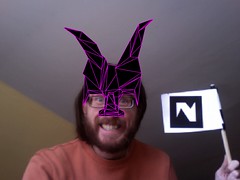- Augmented Reality Magic Mirror
- A type of augmented reality (AR) system/rig where a glyph is displayed to a camera and a video display shows the video captured by the camera with the augmented reality data overlayed. The end result is that the video display looks something like a mirror–showing the user, the glyph and the augmented reality data all at once. This contrasts with the Magic Lens type of augmented reality.
- For example: A glyph is distributed on a postcard. The user logs into an augmented reality website. The website activates the user’s webcam and asks the user to present the glyph. The user shows the glyph to the webcam. The augmented reality website then displays a 3D model or other digital information mapped over the glyph in the live webcam display.






